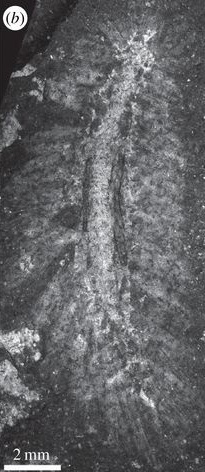Phragmochaeta on:
[Wikipedia]
[Google]
[Amazon]
''Phragmochaeta canicularis'' is an extinct animal belonging to the
at
 Drawing from roughly 40 fossils ''Phragmochaeta'' consisted of about twenty segments, each of which carried structures typical of the annelids
Drawing from roughly 40 fossils ''Phragmochaeta'' consisted of about twenty segments, each of which carried structures typical of the annelids
 ''Polychaetes'' are rare in the
''Polychaetes'' are rare in the
annelids
The annelids (), also known as the segmented worms, are animals that comprise the phylum Annelida (; ). The phylum contains over 22,000 extant species, including ragworms, earthworms, and leeches. The species exist in and have adapted to vario ...
and lived in the Early Cambrian
The Cambrian ( ) is the first geological period of the Paleozoic Era, and the Phanerozoic Eon. The Cambrian lasted 51.95 million years from the end of the preceding Ediacaran period 538.8 Ma (million years ago) to the beginning of the Ordovic ...
(Atdabanian
Cambrian Stage 3 is the still unnamed third stage of the Cambrian. It succeeds Cambrian Stage 2 and precedes Cambrian Stage 4, although neither its base nor top have been formally defined. The plan is for its lower boundary to correspond approxi ...
in the local timescale, about 520 million years ago).''Phragmochaeta canicularis''at
Fossilworks
Fossilworks was a portal which provides query, download, and analysis tools to facilitate access to the Paleobiology Database, a large relational database assembled by hundreds of paleontologists from around the world.
History
Fossilworks was cr ...
.org Fossils have only been found in the Buen Formation
The Buen Formation is a Formation (geology), geologic formation and Lagerstätte in Peary Land, North Greenland. The shale preserves fossils dating back to the Early Cambrian Period (geology), period (Atdabanian in the local timescale, about 520 ...
at the Sirius Passet
Sirius Passet is a Cambrian Lagerstätte in Peary Land, Greenland. The Sirius Passet Lagerstätte was named after the Slædepatruljen Sirius, Sirius sledge patrol that operates in North Greenland. It comprises six places in Nansen Land, on the eas ...
Lagerstätte
A Fossil-Lagerstätte (, from ''Lager'' 'storage, lair' '' Stätte'' 'place'; plural ''Lagerstätten'') is a sedimentary deposit that preserves an exceptionally high amount of palaeontological information. ''Konzentrat-Lagerstätten'' preserv ...
, Greenland and the animal is probably the first polychaete.
Etymology
The genus name ''Phragmochaeta'' references the thatch−like appearance of the chaetae, hence reeds (Greek: ''phragmites'').Conway Morris & Peel, 2008, p.144 The speciesepithet
An epithet (, ), also a byname, is a descriptive term (word or phrase) commonly accompanying or occurring in place of the name of a real or fictitious person, place, or thing. It is usually literally descriptive, as in Alfred the Great, Suleima ...
''canicularis'' is derived from the Latin for "dog" (''canis'') in reference to Sirius ("dog-star") Passet.Conway Morris & Peel, 2008, p.145
Description
 Drawing from roughly 40 fossils ''Phragmochaeta'' consisted of about twenty segments, each of which carried structures typical of the annelids
Drawing from roughly 40 fossils ''Phragmochaeta'' consisted of about twenty segments, each of which carried structures typical of the annelids polychaetes
Polychaeta () is a paraphyletic class of generally marine annelid worms, commonly called bristle worms or polychaetes (). Each body segment has a pair of fleshy protrusions called parapodia that bear many bristles, called chaetae, which are m ...
(notochaetae and neurochetae). The notochaetae seemed to cover the entire dorsal surface, while the neurochaetae projected obliquely along the axis of the body. The head is not well known, but it seems there was no type of jaw. The intestine was unbent and has large longitudinal musculature.
Lifestyle
It probably was abenthic
The benthic zone is the ecological region at the lowest level of a body of water such as an ocean, lake, or stream, including the sediment surface and some sub-surface layers. The name comes from the Ancient Greek word (), meaning "the depths". ...
animal, which lived on the bottom of the sea and probably ate particles present on the seabed. This animal moved thanks to the neurochete, while the dorsal notochets provided protection.
Classification
This animal belonged to the annelates polychaetes, a group of animals currently represented by numerous marine species. Already in the middle Cambrian of Burgess Shales they were present with numerous species (''Burgessochaeta
''Burgessochaeta'' is an extinct genus of polychaete annelids from the Middle Cambrian. Its fossils have been found in the Burgess Shale in British Columbia, Canada. The genus was described by Conway Morris (1979) and re-examined by Eibye-Jacob ...
'', '' Canadia'', '' Peronochaeta''), but Phragmochaeta, antecedent of some millions of years, represents the oldest polychaete and was probably one of the most primitive.
Importance
Maotianshan Shales
The Maotianshan Shales () are a series of Early Cambrian sedimentary deposits in the Chiungchussu Formation or Heilinpu Formation, famous for their '' Konservat Lagerstätten'', deposits known for the exceptional preservation of fossilized orga ...
, in China, also dating back to the lower Cambrian. This is particularly surprising because the Chinese field has a very wide biological variety. The only Cambrian field containing polychaetes is that of Burgess Shale
The Burgess Shale is a fossil-bearing deposit exposed in the Canadian Rockies of British Columbia, Canada. It is famous for the exceptional preservation of the soft parts of its fossils. At old (middle Cambrian), it is one of the earliest fos ...
, in Canada, a little later. ''Phragmochaeta'', therefore, represents an exception as the oldest known polychaete.
References
Bibliography
* {{Taxonbar, from=Q3901706 Polychaetes Cambrian invertebrates Cambrian animals of North America Cambrian Greenland Fossils of Greenland Buen Formation Fossil taxa described in 2008 Cambrian genus extinctions